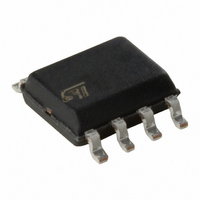M93C66-WMN6P STMicroelectronics, M93C66-WMN6P Datasheet - Page 11

M93C66-WMN6P
Manufacturer Part Number
M93C66-WMN6P
Description
IC EEPROM 4KBIT 2MHZ 8SOIC
Manufacturer
STMicroelectronics
Datasheets
1.M93C46-WMN6TP.pdf
(36 pages)
2.M93C46-WMN6TP.pdf
(37 pages)
3.M93C46-WBN6P.pdf
(31 pages)
Specifications of M93C66-WMN6P
Format - Memory
EEPROMs - Serial
Memory Type
EEPROM
Memory Size
4K (512 x 8 or 256 x 16)
Speed
2MHz
Interface
Microwire, 3-Wire Serial
Voltage - Supply
2.5 V ~ 5.5 V
Operating Temperature
-40°C ~ 85°C
Package / Case
8-SOIC (3.9mm Width)
Organization
512 x 8
Interface Type
Microwire
Maximum Clock Frequency
2 MHz
Supply Voltage (max)
5.5 V
Supply Voltage (min)
2.5 V
Maximum Operating Current
2 mA
Maximum Operating Temperature
+ 85 C
Mounting Style
SMD/SMT
Minimum Operating Temperature
- 40 C
Operating Supply Voltage
2.5 V, 5.5 V
Memory Configuration
512 X 8, 256 X 16
Clock Frequency
2MHz
Supply Voltage Range
2.5V To 5.5V
Memory Case Style
SOIC
No. Of Pins
8
Rohs Compliant
Yes
Lead Free Status / RoHS Status
Lead free / RoHS Compliant
Other names
497-5672-5
Available stocks
Company
Part Number
Manufacturer
Quantity
Price
Part Number:
M93C66-WMN6P
Manufacturer:
ST
Quantity:
20 000
READY/BUSY STATUS
While the Write or Erase cycle is underway, for a
WRITE, ERASE, WRAL or ERAL instruction, the
Busy signal (Q=0) is returned whenever Chip Se-
lect Input (S) is driven High. (Please note, though,
that there is an initial delay, of t
status information becomes available). In this
state, the M93Cx6 ignores any data on the bus.
When the Write cycle is completed, and Chip Se-
lect Input (S) is driven High, the Ready signal
(Q=1) indicates that the M93Cx6 is ready to re-
ceive the next instruction. Serial Data Output (Q)
remains set to 1 until the Chip Select Input (S) is
brought Low or until a new start bit is decoded.
COMMON I/O OPERATION
Serial Data Output (Q) and Serial Data Input (D)
can be connected together, through a current lim-
iting resistor, to form a common, single-wire data
bus. Some precautions must be taken when oper-
ating the memory in this way, mostly to prevent a
short circuit current from flowing when the last ad-
dress bit (A0) clashes with the first data bit on Se-
rial Data Output (Q). Please see the application
note AN394 for details.
Figure 7. Write Sequence with One Clock Glitch
S
D
C
START
"0"
WRITE
SLSH
"1"
, before this
An
M93C86, M93C76, M93C66, M93C56, M93C46
Glitch
An-1
CLOCK PULSE COUNTER
In a noisy environment, the number of pulses re-
ceived on Serial Clock (C) may be greater than the
number delivered by the master (the microcontrol-
ler). This can lead to a misalignment of the instruc-
tion of one or more bits (as shown in
may lead to the writing of erroneous data at an er-
roneous address.
To combat this problem, the M93Cx6 has an on-
chip counter that counts the clock pulses from the
start bit until the falling edge of the Chip Select In-
put (S). If the number of clock pulses received is
not the number expected, the WRITE, ERASE,
ERAL or WRAL instruction is aborted, and the
contents of the memory are not modified.
The number of clock cycles expected for each in-
struction, and for each member of the M93Cx6
family, are summarized in
example, a Write Data to Memory (WRITE) in-
struction on the M93C56 (or M93C66) expects 20
clock cycles (for the x8 organization) from the start
bit to the falling edge of Chip Select Input (S). That
is:
ARE SHIFTED BY ONE BIT
ADDRESS AND DATA
An-2
1 Start bit
+ 2 Op-code bits
+ 9 Address bits
+ 8 Data bits
D0
Table 5.
to
AI01395
Figure
Table
7.) and
7.. For
11/31
















